Significant Decrease in Heavy Metals in Surface Sediment after Ten-Year Sustainable Development in Huaxi Reservoir Located in Guiyang, Southwestern China
Abstract
:1. Introduction
2. Materials and Methods
2.1. Study Area
2.2. Sample Collection
2.3. Sample Analysis
2.4. Methods for Evaluation of Pollution Risk
2.4.1. Sediment Quality Guidelines
2.4.2. Geo-Accumulation Index (Igeo)
2.4.3. Contamination Factor (CF)
2.4.4. Potential Ecological Risk Index ()
2.4.5. Enrichment Factor (EF)
2.4.6. Toxic Risk Index (TRI)
2.4.7. Modified Hazard Quotient (mHQ)
2.4.8. Ecological Contamination Index (ECI)
2.4.9. Potential Human Health Risk Assessment
2.5. Statistical Analyses
3. Results
3.1. Spatial and Temporal Trends of Heavy Metals
3.1.1. Temporal Changes
3.1.2. Spatial Distributions and Their Affecting Factors
Spatial Distributions
Affecting Factors
3.2. Assessment of Heavy Metal Contamination
3.2.1. Sediment Quality Guidelines
3.2.2. Geo-Accumulation Index (Igeo) of Metals
3.2.3. Contamination Factor (CF) and Potential Ecological Risk Index (Eir)
3.2.4. Potential Acute Toxicity of Metals
3.2.5. EF, mHQ, ECI and TRI Values
3.2.6. Health Risk Evaluation of Metals
3.3. Source Analysis of Heavy Metals
4. Discussions
4.1. Different Spatial Patterns Following Water Flow Direction
4.2. Differences among These Risk or Pollution Indices
4.3. Source Analysis and Management in the Future
5. Conclusions
Author Contributions
Funding
Conflicts of Interest
References
- Sun, M.X.; Wang, T.; Xu, X.B.; Zhang, L.X.; Li, J.; Shi, Y.J. Ecological risk assessment of soil cadmium in China’s coastal economic development zone: A meta-analysis. Ecosyst. Health Sustain. 2020, 6, 1733921. [Google Scholar] [CrossRef] [Green Version]
- Islam, M.S.; Ahmed, M.K.; Raknuzzaman, M.; Habibullah-Al-Mamun, M.; Islam, M.K. Heavy metal pollution in surface water and sediment: A preliminary assessment of an urban river in a developing country. Ecol. Indic. 2015, 48, 282–291. [Google Scholar] [CrossRef]
- Ding, Z.W.; Li, Y.; Sun, Q.Y.; Zhang, H.J. Trace elements in soils and selected agricultural plants in the Tongling mining Area of China. Int. J. Environ. Res. Public Health 2018, 15, 202. [Google Scholar] [CrossRef] [PubMed] [Green Version]
- Qiao, D.H.; Wang, G.S.; Li, X.S.; Wang, S.; Zhao, Y.Y. Pollution, sources and environmental risk assessment of heavy metals in the surface AMD water, sediments and surface soils around unexploited Rona Cu deposit, Tibet, China. Chemosphere 2020, 248, 125988. [Google Scholar] [CrossRef] [PubMed]
- Liu, C.C.; Yin, J.; Hu, L.; Zhang, B. Spatial Distribution of Heavy Metals and Associated Risks in Sediment of the Urban River Flowing into the Pearl River Estuary, China. Arch. Environ. Contam. Toxicol. 2020, 78, 622–630. [Google Scholar] [CrossRef]
- Authman, M.M.; Abbas, H.H.; Abbas, W.T. Assessment of metal status in drainage canal water and their bioaccumulation in Oreochromis niloticus fish in relation to human health. Environ. Monit. Assess. 2015, 185, 891–907. [Google Scholar] [CrossRef]
- Cheng, H.X.; Li, M.; Zhao, C.D. Concentrations of toxic metals and ecological risk assessment for sediments of major freshwater lakes in China. J. Geochem. Explor. 2015, 157, 15–26. [Google Scholar] [CrossRef]
- Liu, G.N.; Wang, J.; Liu, X.; Liu, X.H.; Li, X.S.; Ren, Y.Q.; Wang, J.; Dong, L.M. Partitioning and geochemical fractions of heavy metals from geogenic and anthropogenic sources in various soil particle size fractions. Geoderma 2018, 312, 104–113. [Google Scholar] [CrossRef]
- Wang, Z.F.; Zhou, J.Y.; Zhang, C.; Qu, L.Y.; Mei, K.M.; Dahlgren, R.A.; Zhang, M.H.; Xia, F. A comprehensive risk assessment of metals in riverine surface sediments across the rural-urban interface of a rapidly developing watershed. Environ. Pollut. 2019, 245, 1022–1030. [Google Scholar] [CrossRef] [Green Version]
- Xia, W.L.; Chen, L.; Deng, X.W.; Liang, G.D.; Giesy, J.P.; Rao, Q.Y.; Wen, Z.H.; Wu, Y.; Chen, J.; Xie, P. Spatial and interspecies differences in concentrations of eight trace elements in wild freshwater fishes at different trophic levels from middle and eastern China. Sci. Total Environ. 2019, 672, 883–892. [Google Scholar] [CrossRef]
- Qian, Y.; Cheng, C.L.; Feng, H.; Hong, Z.J.; Zhu, Q.Z.; Kolencik, M.; Chang, X.X. Assessment of metal mobility in sediment, commercial fish accumulation and impact on human health risk in a large shallow plateau lake in southwest of China. Ecotoxicol. Environ. Saf. 2020, 194, 110346. [Google Scholar] [CrossRef]
- Feng, X.; Qiu, G. Mercury pollution in Guizhou, Southwestern China-An overview. Sci. Total Environ. 2008, 400, 227–237. [Google Scholar] [CrossRef]
- Guo, W.; Huo, S.L.; Xi, B.D.; Zhang, J.T.; Wu, F.C. Heavy metal contamination in sediments from typical lakes in the five geographic regions of China: Distribution, bioavailability, and risk. Ecol. Eng. 2015, 81, 243–255. [Google Scholar] [CrossRef]
- Jiang, F.; Ren, B.Z.; Hursthouse, A.; Deng, R.J.; Wang, Z.H. Distribution, source identification, and ecological-health risks of potentially toxic elements (PTEs) in soil of thallium mine area (southwestern Guizhou, China). Environ. Sci. Pollut. Res. 2019, 26, 16556–16567. [Google Scholar] [CrossRef] [Green Version]
- Shen, W.D.; Xiong, K.N.; Gao, Y.; Quan, M.Y.; Peng, H.J.; Yan, T.; He, L.F.; Bao, K.S. Distribution of Potential Harmful Trace Elements and Potential Ecological Risk in the Jiulongchi Wetland of Fanjing Mountain, Southwest China. Int. J. Environ. Res. Public Health 2020, 17, 1731. [Google Scholar] [CrossRef] [Green Version]
- Luo, K.; Liu, H.Y.; Yu, E.J.; Tu, Y.; Gu, X.F.; Xu, M. Distribution and release mechanism of heavy metals in sediments of Yelang Lake by DGT. Stoch. Environ. Res. Risk Assess. 2020, 34, 793–805. [Google Scholar] [CrossRef]
- Pejman, A.; Bidhendi, N.G.; Ardestani, M.; Saeedi, M.; Baghvand, A. A new index for assessing heavy metals contamination in sediments: A case study. Ecol. Indic. 2015, 58, 365–373. [Google Scholar] [CrossRef]
- Benson, N.U.; Adedapo, A.E.; Fred-Ahmadu, O.H.; Williams, A.B.; Udosen, E.D.; Ayejuyo, O.O.; Olajire, A.A. A new method for assessment of sediment-associated contamination risks using multivariate statistical approach. MethodsX 2018, 5, 268–276. [Google Scholar] [CrossRef]
- Bo, L.J.; Wang, D.J.; Li, T.L.; Li, Y.; Zhang, G.; Wang, C.; Zhang, S.Q. Accumulation and risk assessment of heavy metals in water, sediments, and aquatic organisms in rural rivers in the Taihu Lake region, China. Environ. Sci. Pollut. Res. 2015, 22, 6721–6731. [Google Scholar] [CrossRef]
- Bradl, H.B. Adsorption of heavy metal ions on soils and soils constituents. J. Colloid Interface Sci. 2004, 277, 1–18. [Google Scholar] [CrossRef]
- Chai, L.Y.; Li, H.; Yang, Z.H.; Min, X.B.; Liao, Q.; Liu, Y.; Men, S.H.; Yan, Y.N.; Xu, J.X. Heavy metals and metalloids in the surface sediments of the Xiangjiang River, Hunan, China: Distribution, contamination, and ecological risk assessment. Environ. Sci. Pollut. Res. 2017, 24, 874–885. [Google Scholar] [CrossRef] [PubMed]
- Ustaoğlu, F.; Islam, M.S. Potential toxic elements in sediment of some rivers at Giresun, Northeast Turkey: A preliminary assessment for ecotoxicological status and health risk. Ecol. Indic. 2020, 113, 106237. [Google Scholar] [CrossRef]
- Karthikeyan, P.; Vennila, G.; Venkatachalapathy, R.; Subramani, T.; Prakash- Aswini, M.K. Assessment of heavy metals in the surface sediments of the Emerald Lake using of spatial distribution and multivariate techniques. Environ. Monit. Assess. 2018, 190, 668. [Google Scholar] [CrossRef] [PubMed]
- Liu, Q.Q.; Wang, F.F.; Meng, F.P.; Jiang, L.; Li, G.J.; Zhou, R.G. Assessment of metal contamination in estuarine surface sediments from Dongying City, China: Use of a modified ecological risk index. Mar. Pollut. Bull. 2018, 126, 293–303. [Google Scholar] [CrossRef]
- Bai, J.H.; Zhao, Q.Q.; Lu, Q.Q.; Wang, J.J.; Reddy, K.R. Effects of freshwater input on trace element pollution in salt marsh soils of a typical coastal estuary, China. J. Hydrol. 2015, 520, 186–192. [Google Scholar] [CrossRef]
- Li, Y.Y.; Gao, B.; Xu, D.Y.; Peng, W.Q.; Liu, X.B.; Qu, X.D.; Zhang, M. Hydrodynamic impact on trace metals in sediments in the cascade reservoirs, North China. Sci. Total Environ. 2020, 716, 136914. [Google Scholar] [CrossRef]
- Li, F.; Zeng, X.Y.; Wu, C.H.; Duan, Z.P.; Wen, Y.M.; Huang, G.R.; Long, X.L.; Li, M.J.; Li, M.J.; Xu, J.Y. Ecological risks assessment and pollution source identification of trace elements in contaminated sediments from the Pearl River Delta, China. Biol. Trace Elem. Res. 2013, 155, 301–313. [Google Scholar] [CrossRef] [Green Version]
- Yang, Z.F.; Wang, Y.; Shen, Z.Y.; Niu, J.F.; Tang, Z.W. Distribution and speciation of heavy metals in sediments from the mainstream, tributaries, and lakes of the Yangtze River catchment of Wuhan, China. J. Hazard. Mater. 2009, 166, 1186–1194. [Google Scholar] [CrossRef]
- Huang, L.L.; Pu, X.M.; Pan, J.F.; Wang, B. Heavy metal pollution status in surface sediments of Swan Lake lagoon and Rongcheng Bay in the northern Yellow Sea. Chemosphere 2013, 93, 1957–1964. [Google Scholar] [CrossRef]
- Diami, S.M.; Kusin, F.M.; Madzin, Z. Potential ecological and human health risks of heavy metals in surface soils associated with iron ore mining in Pahang, Malaysia. Environ. Sci. Pollut. Res. 2016, 23, 21086–21097. [Google Scholar] [CrossRef]
- Deng, M.H.; Yang, X.; Dai, X.; Zhang, Q.; Malik, A.; Sadeghpour, A. Heavy metal pollution risk assessments and their transportation in sediment and overlay water for the typical Chinese reservoirs. Ecol. Indic. 2020, 112, 106166. [Google Scholar] [CrossRef]
- Xu, X.; Zhi, C.Y.; Chen, L. Potential ecological risk assessment of heavy metal in surface sediments from the Huaxi reservoir. Environ. Monit. China 2012, 28, 76–78. [Google Scholar]
- HJ832-2017; Soil and Sediment-Digestion of Total Metal Elements-Microwave Assisted Acid Digestion Method; Ministry of Environmental Protection: Beijing, China, 2017.
- Hübner, R.; Brian, A.K.; Herbert, R.J.H. Comparison of sediment quality guidelines (SQGs) for the assessment of metal contamination in marine and estuarine environments. J. Environ. Monit. 2009, 11, 713–722. [Google Scholar] [CrossRef]
- MacDonald, D.D.; Ingersoll, C.G.; Berger, T.A. Development and Evaluation of Consensus-Based Sediment Quality Guidelines for Freshwater Ecosystems. Arch. Environ. Contam. Toxicol. 2000, 39, 20–31. [Google Scholar] [CrossRef]
- Jiang, X.X. Influence of Temporal Spatial Variation of Heavy Metals on Diatoms Distribution in Surface Sediments of in Aha Reservoirs; Guizhou Normal University: Guiyang, China, 2007. [Google Scholar]
- Tian, L.F.; Hu, J.W.; Luo, G.L.; Ma, J.J.; Huang, X.F.; Qin, F.X. Ecological risk and stability of heavy metals in sediments from Lake Baihua in Guizhou Province. Acta Sci. Circumstantiae 2012, 32, 885–894. [Google Scholar]
- Liu, F.; Hu, J.W.; Qin, F.X.; Wu, D.; Li, C.X.; Huang, X.F.; Jiang, C.H. An assessment of heavy metal contamination sources in sediments from Hongfeng Lake. Acta Sci. Circumstantiae 2010, 30, 1871–1879. [Google Scholar]
- Yan, M.C.; Chi, Q.H.; Gu, T.X. Average element content of various sediments in China. Geophys. Geochem. Explor. 1995, 19, 468–472. [Google Scholar]
- State Environmental Protection Administration Background Values of Soil Elements in China; China Environmental Science Press: Beijing, China, 1990; pp. 335–379.
- Turekian, K.K.; Wedepohl, K.H. Distribution of the elements in some major units of the earth’s crust. Bull. Geol. Soc. Am. 1961, 72, 175–192. [Google Scholar] [CrossRef]
- Håkanson, L. An ecological risk index for aquatic pollution control a sedimentological approach. Water Res. 1980, 14, 975–1001. [Google Scholar] [CrossRef]
- Loska, K.; Cebula, J.; Pelczar, J.; Wiechuła, D.; Kwapulinski, J. Use of enrichment and contamination factors together with geo-accumulation indexes to evaluate the content of Cd, Cu, and Ni in the Rybnik water reservoir in Poland. Water Air Soil Pollut. 1997, 93, 347–365. [Google Scholar] [CrossRef]
- Maanan, M.; Saddik, M.; Maanan, M.; Chaibi, M.; Assobhei, O.; Zourarah, B. Environmental and ecological risk assessment of heavy metals in sediments of Nador lagoon, Morocco. Ecol. Indic. 2015, 48, 616–626. [Google Scholar] [CrossRef]
- Franco-Uria, A.; Lopez-Mateo, C.; Roca, E.; Fernandez-Marcos, M.L. Source identification of heavy metals in pasture land by multivariate analysis in NW Spain. J. Hazard. Mater. 2009, 165, 1008–1015. [Google Scholar] [CrossRef]
- Harikrishnan, N.; Ravisankar, R.; Chandrasekaran, A.; Suresh, G.M.; Kanagasabapathy, K.V.; Prasad, M.V.R.; Satapathy, K.K. Assessment of heavy metal contamination in marine sediments of East coast of Tamil Nadu affected by different pollution sources. Mar. Pollut. Bull. 2017, 121, 418–424. [Google Scholar] [CrossRef] [PubMed]
- Wang, X.J.; Fu, R.L.; Li, H.L.; Zhang, Y.; Lu, M.Q.; Xiao, K.; Zhang, X.L.; Zheng, C.M.; Xiong, Y. Heavy metal contamination in surface sediments: A comprehensive, large-scale evaluation for the Bohai Sea, China. Environ. Pollut. 2020, 260, 113986. [Google Scholar] [CrossRef] [PubMed]
- Sinex, S.A.; Helz, G.R. Regional geochemistry of trace elements in Chesapeake Bay sediments. Environ. Geol. 1981, 3, 315–323. [Google Scholar] [CrossRef]
- Ravichandran, M.; Baskaran, M.; Santschi, P.H.; Bianchi, T.S. History of trace metal pollution in Sabine-Neches Estuary, Beaumont Texas. Environ. Sci. Technol. 1995, 29, 1495–1503. [Google Scholar] [CrossRef] [PubMed]
- Sutherland, R. Bed sediment-associated trace metals in an urban stream, Oahu, Hawaii. Environ. Geol. 2000, 39, 611–627. [Google Scholar] [CrossRef]
- Kükrer, S.; Çakır, Ç.; Kaya, H.N.; Erginal, A.E. Historical record of metals in Lake Küçükçekmece and Lake Terkos (Istanbul, Turkey) based on anthropogenic impacts and ecological risk assessment. Environ. Forensics 2019, 20, 385–401. [Google Scholar] [CrossRef]
- Yang, Q.Q.; Li, Z.Y.; Lu, X.N.; Duan, Q.N.; Huang, L.; Bi, J. A review of soil heavy metal pollution from mines in China: Pollution and health risk assessment. Sci. Total Environ. 2018, 642, 690–700. [Google Scholar] [CrossRef]
- Luo, X.S.; Ding, J.; Xu, B.; Wang, Y.J.; Li, H.B.; Yu, S. Incorporating bio-accessibility into human risk assessments of heavy metals in urban park soils. Sci. Total Environ. 2012, 424, 88–96. [Google Scholar] [CrossRef]
- Yuswir, N.S.; Praveena, S.M.; Aris, A.Z.; Ismail, S.N.S.; Hashim, Z. Health risk assessment of heavy metal in urban surface soil (Klang District, Malaysia). Bull. Environ. Contam. Toxicol. 2015, 95, 80–89. [Google Scholar] [CrossRef]
- US Environmental Protection Agency (USEPA). Supplemental Guidance for Developing Soil Screening Levels for Superfund Sites, OSWER 9355; Office of Emergency and Remedial Response: Washington, DC, USA, 2002.
- US Environmental Protection Agency (USEPA). Integrated Risk Information System of the US Environmental Protection Agency; US Environmental Protection Agency (USEPA): Washington, DC, USA, 2012.
- US Environmental Protection Agency (USEPA). Exposure Factors Handbook; National Center for Environmental Assessment: Washington, DC, USA, 2011.
- Helsel, D.R.; Hirsch, R.M.; Ryberg, K.R. Statistical Methods in Water Resources; Geological Survey: Reston, VA, USA, 2002. [Google Scholar]
- Rencher, A.C. Methods of Multivariate Analysis; John Wiley & Sons: Hoboken, NJ, USA, 2003. [Google Scholar]
- Cao, Y.X.; Lei, K.; Zhang, X.; Xu, L.; Lin, C.Y.; Yang, Y.N. Contamination and ecological risks of toxic metals in the Hai River, China. Ecotoxicol. Environ. Saf. 2018, 164, 210–221. [Google Scholar] [CrossRef]
- Zhang, X.W.; Wei, S.; Sun, Q.Q.; Wadood, S.A.; Guo, B.L. Source identification and spatial distribution of arsenic and heavy metals in agricultural soil around Hunan industrial estate by positive matrix factorization model, principal components analysis and geo statistical analysis. Ecotoxicol. Environ. Saf. 2018, 159, 354–362. [Google Scholar] [CrossRef]
- Nriagu, J.O.; Bhattacharya, P.; Mukherjee, A.B.; Bundschuh, J.; Zevenhoven, R.; Loeppert, R.H. Arsenic in soil and groundwater: An overview. Trace Met. Other Contam. 2007, 9, 3–60. [Google Scholar]
- Mohiuddin, K.M.; Otomo, K.; Ogawa, Y.; Shikazono, N. Seasonal and spatial distribution of trace elements in the water and sediments of the Tsurumi River in Japan. Environ. Monit. Assess. 2012, 184, 265–279. [Google Scholar] [CrossRef]
- Quinton, J.N.; Catt, J.A. Enrichment of heavy metals in sediment resulting from soil erosion on agricultural fields. Environ. Sci. Technol. 2007, 41, 3495–3500. [Google Scholar] [CrossRef]
- Zheng, N.; Wang, Q.; Liang, Z.; Zheng, D. Characterization of heavy metal concentrations in the sediments of three freshwater rivers in Huludao City, Northeast China. Environ. Pollut. 2008, 154, 135–142. [Google Scholar] [CrossRef]
- Pedersen, F.; Bjørnestad, E.; Andersen, H.V.; Kjølholt, J.; Poll, C. Characterization of sediments from Copenhagen Harbour by use of biotests. Water Sci. Technol. 1998, 37, 233–240. [Google Scholar] [CrossRef]
- Wang, S.L.; Lin, C.Y.; Cao, X.Z. Heavy metals content and distribution in the surface sediments of the Guangzhou section of the Pearl River, Southern China. Environ. Earth Sci. 2011, 64, 1593–1605. [Google Scholar] [CrossRef]
- Xiao, R.; Bai, J.H.; Gao, H.F.; Wang, J.J.; Huang, L.B.; Liu, P.P. Distribution and contamination assessment of heavy metals in water and soils from the college town in the Pearl River Delta, China. Clean Soil Air Water 2012, 40, 1167–1173. [Google Scholar] [CrossRef]
- Yan, L.Y.; Fan, C.W.; Liu, G.H.; Hu, G.; Chen, J.B.; Qin, S. Case study of the characteristic features of the nutritious and heavy metal contents in sediments of the Karst rock mountain reservoir in Guizhou. J. Saf. Environ. 2017, 17, 2031–2037. [Google Scholar]
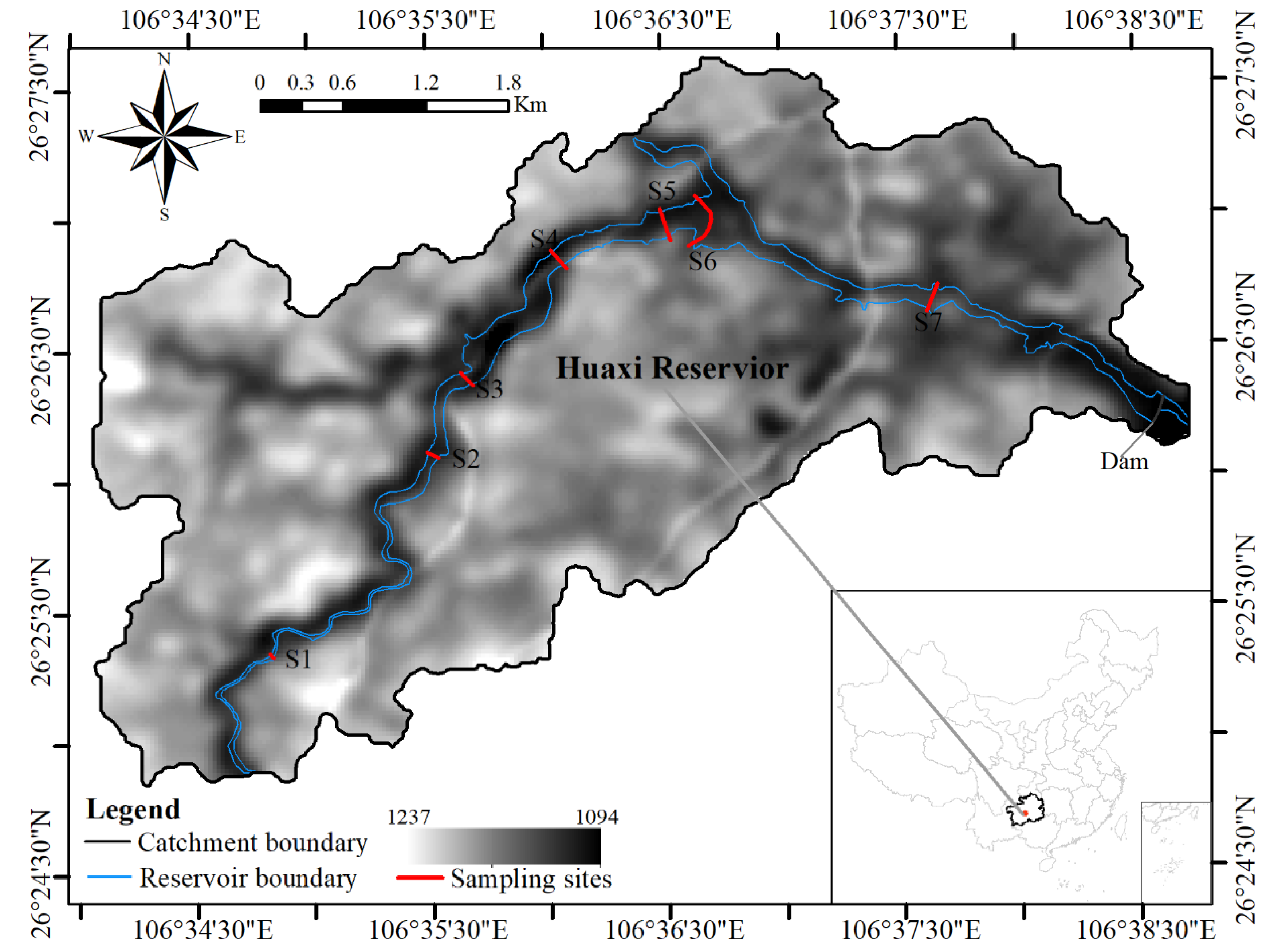
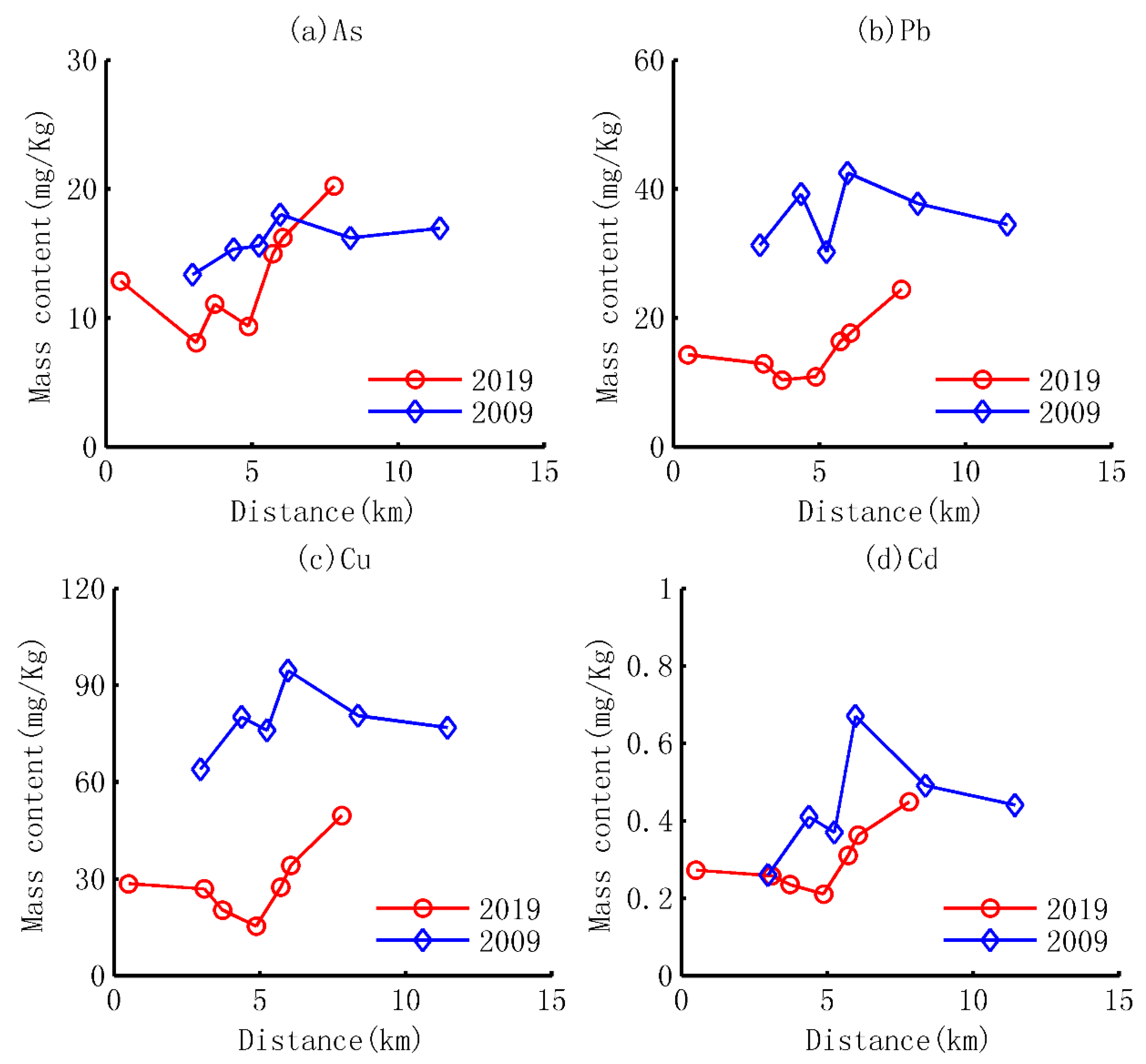

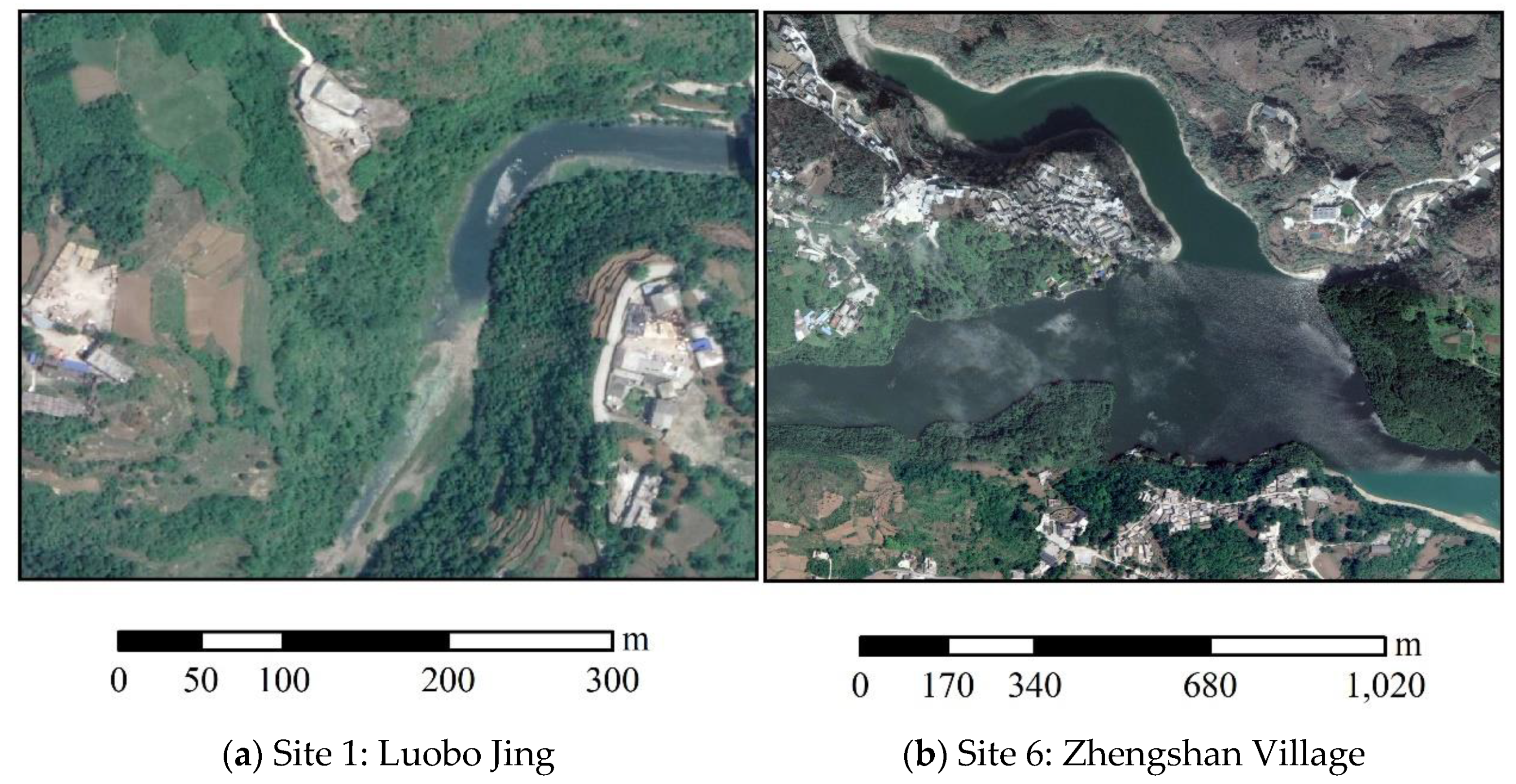
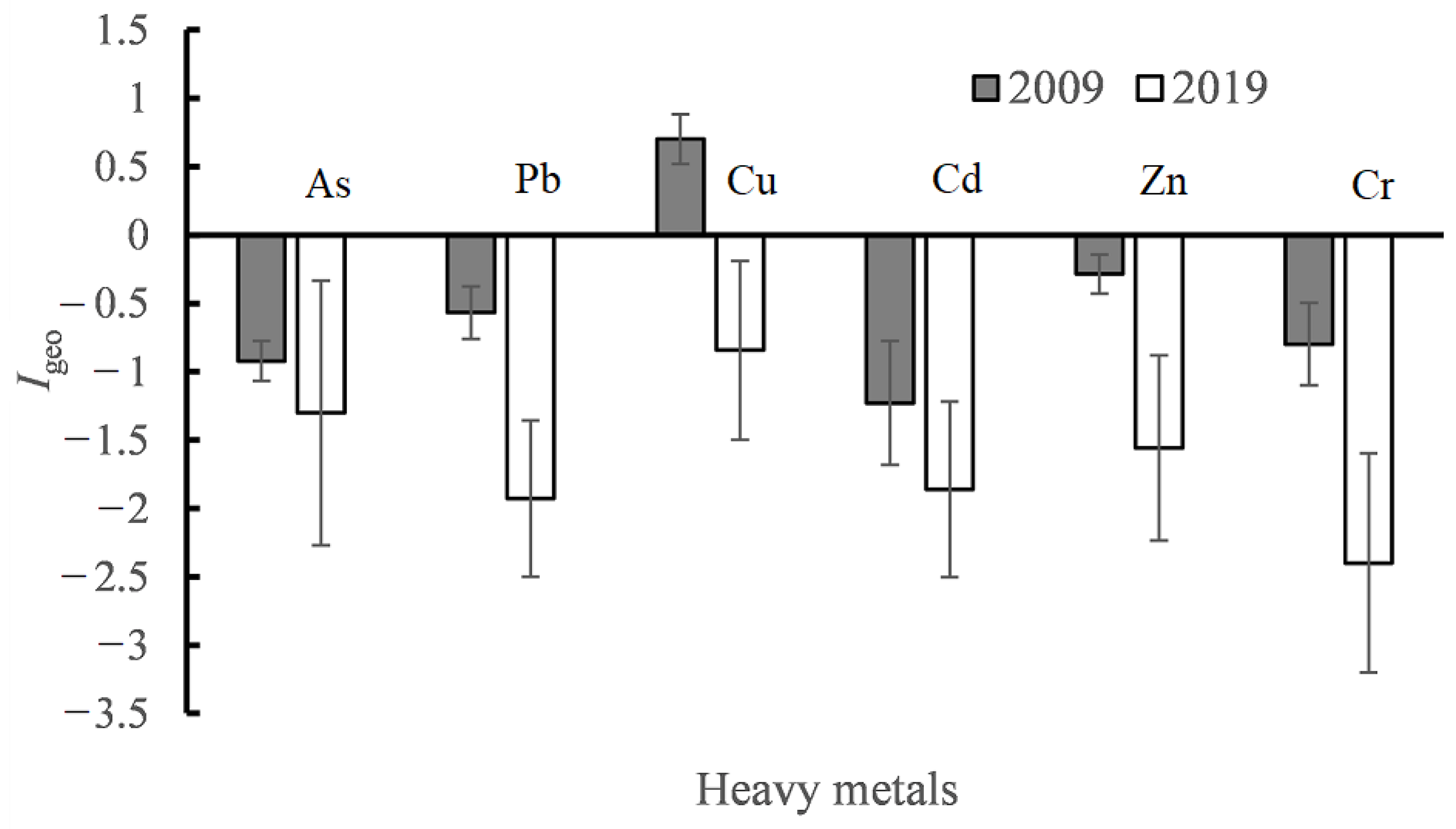

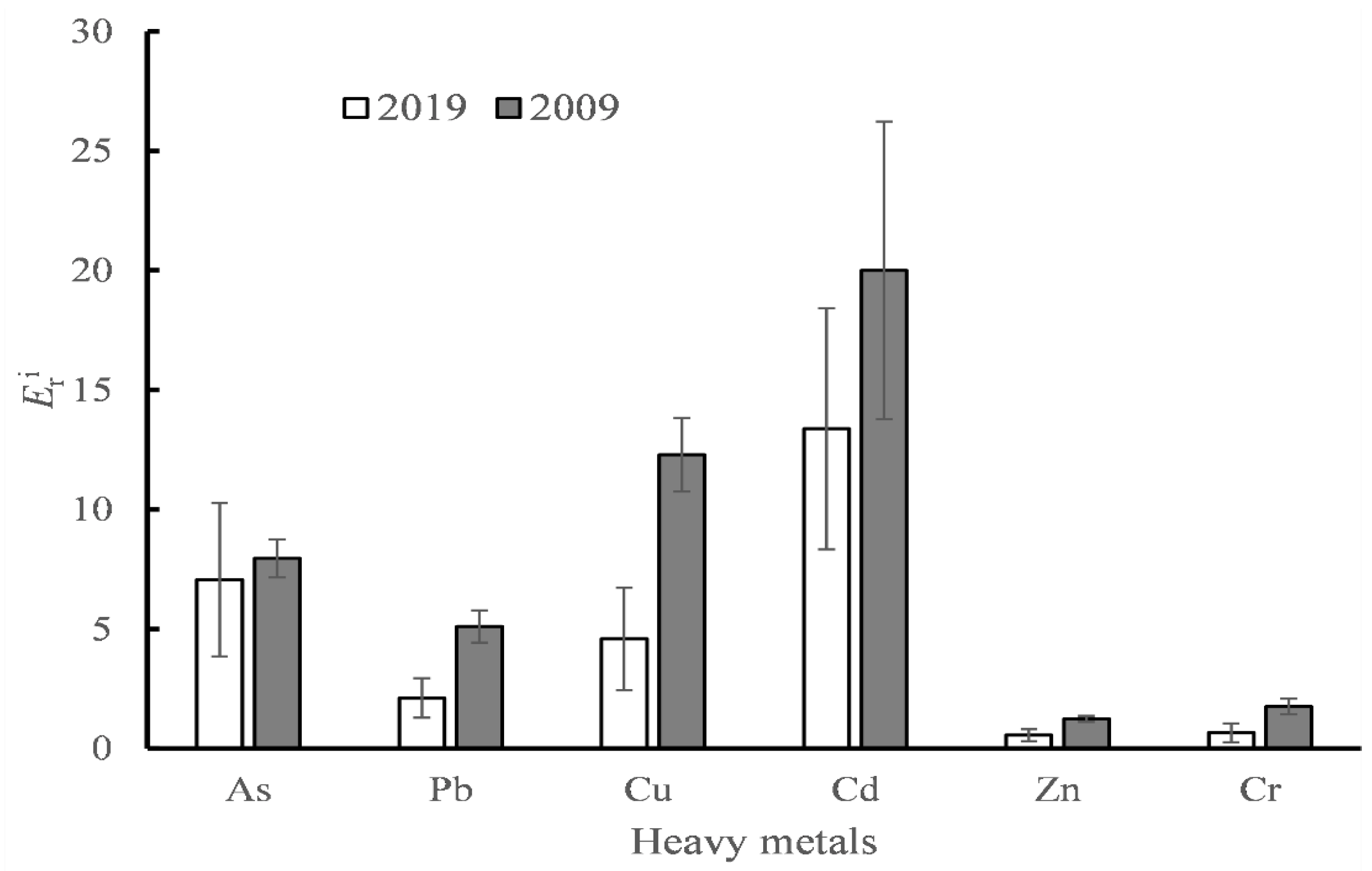
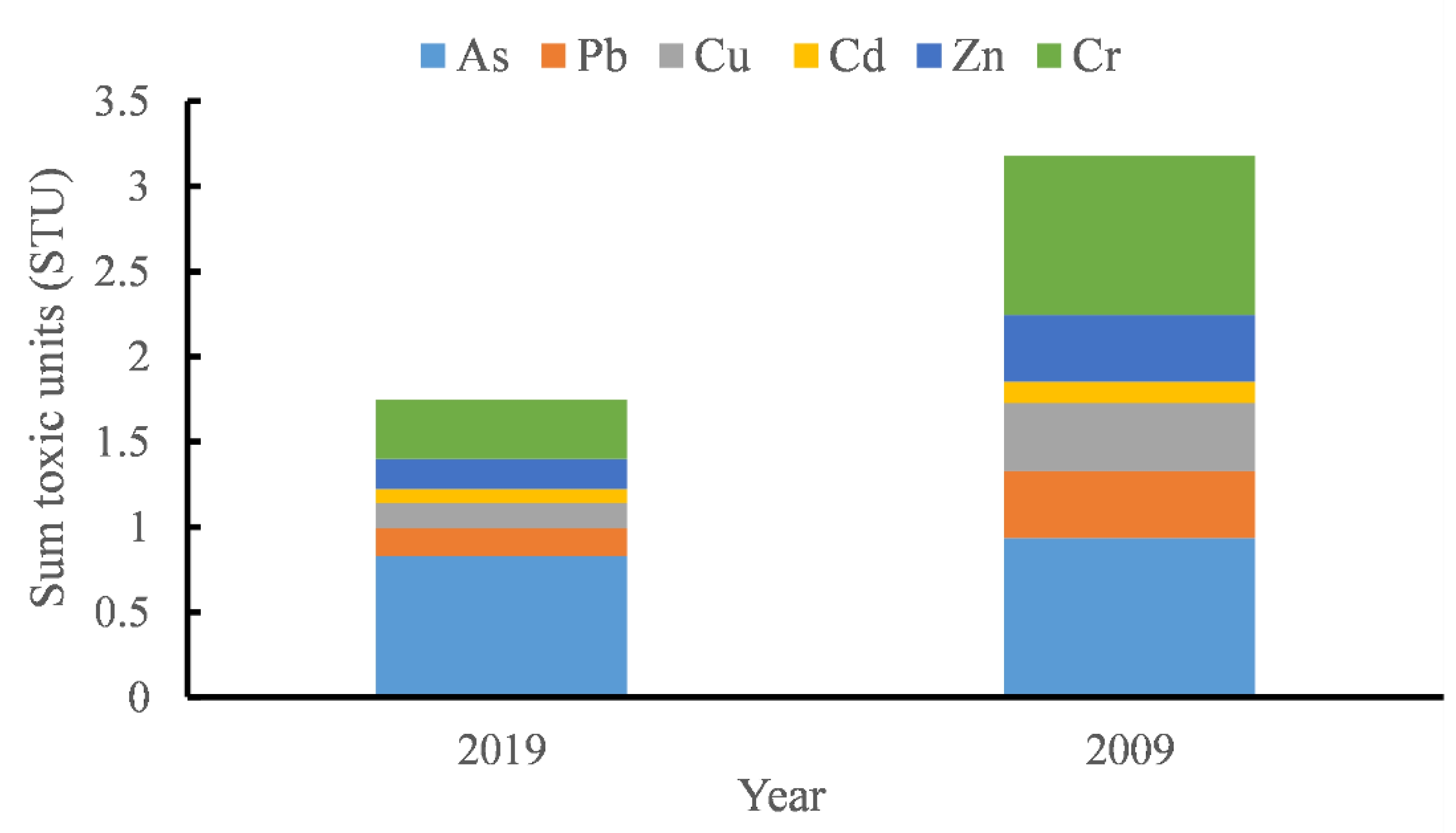
| Reservoir (Lake) and Site | Stats | As | Pb | Cu | Cd | Zn | Cr | Reference |
|---|---|---|---|---|---|---|---|---|
| Huaxi Reservoir, Guiyang, China (2019) | Mean | 13.26 | 14.84 | 29.32 | 0.29 | 55.58 | 31.33 | This study |
| SD | 6.00 | 5.43 | 12.82 | 0.10 | 23.22 | 17.43 | ||
| Min | 2.75 | 7.16 | 15.02 | 0.11 | 24.19 | 12.07 | ||
| Max | 22.34 | 26.12 | 35.91 | 0.48 | 95.12 | 70.89 | ||
| Huaxi Reservoir, Guiyang, China (2009) | Mean | 15.91 | 35.91 | 78.63 | 0.44 | 122.94 | 84.19 | [32] |
| SD | 1.45 | 4.35 | 8.99 | 0.12 | 11.80 | 14.69 | ||
| Min | 13.35 | 31.25 | 63.91 | 0.26 | 111.21 | 57.38 | ||
| Max | 18.01 | 42.50 | 94.51 | 0.67 | 147.24 | 101.21 | ||
| Aha Reservoir, Guiyang, China | Mean | 26.28 | 75.87 | 59.53 | 1.12 | 164.65 | 104.86 | [36] |
| Baihua Lake, Guiyang, China | Mean | - | 40.00 | 68.00 | 0.95 | 339.00 | 66.00 | [37] |
| Hongfeng Lake, Guiyang, China | Mean | 29.70 | 35.90 | 9.19 | 0.77 | 142.00 | 87.90 | [38] |
| Element value of sediments in China | Mean | 9.1 | 25 | 21 | 0.14 | 68 | 38 | [39] |
| Guizhou soil background | Mean | 20.00 | 35.20 | 32.00 | 0.66 | 99.50 | 95.90 | [40] |
| TEL | Mean | 5.9 | 35 | 35.7 | 0.6 | 123 | 37.3 | [35] |
| PEL | Mean | 17 | 91.3 | 197 | 3.53 | 315 | 90 | [35] |
| SEL | Mean | 33 | 250 | 110 | 10 | 820 | 110 | [35] |
| Heavy Metals | As | Pb | Cu | Cd | Zn | Cr |
|---|---|---|---|---|---|---|
| p value | 0.0903 | 0.0006 | 0.0006 | 0.0256 | 0.0006 | 0.0012 |
| H | 0 | 1 | 1 | 1 | 1 | 1 |
| Z stat | −1.69 | −3.44 | −3.44 | −2.23 | −3.44 | −3.25 |
| Rank sum | 39 | 28 | 28 | 35 | 28 | 29 |
| Index | As | Pb | Cu | Cd | Zn | Cr | |
|---|---|---|---|---|---|---|---|
| 2009 | mHQ | 2.03 ± 0.10 | 1.25 ± 0.08 | 1.82 ± 0.11 | 0.95 ± 0.15 | 1.24 ± 0.06 | 1.99 ± 0.19 |
| ECI | 1.78 ± 0.09 | ||||||
| TRI | 7.39 ± 1.01 | ||||||
| 2019 | EF | 1.02 ± 0.46 | 0.61 ± 0.24 | 1.32 ± 0.62 | 0.64 ± 0.24 | 0.81 ± 0.36 | 0.47 ± 0.28 |
| mHQ | 1.91 ± 0.50 | 0.80 ± 0.15 | 1.11 ± 0.24 | 0.78 ± 0.16 | 0.83 ± 0.17 | 1.21 ± 0.35 | |
| ECI | 1.29 ± 0.08 | ||||||
| TRI | 4.03 ± 1.70 | ||||||
| People | Heavy Metals | 2009 | 2019 | ||||||||||||
|---|---|---|---|---|---|---|---|---|---|---|---|---|---|---|---|
| CDIing | CDIinh | CDIderma | HQing | HQinh | HQdermal | HI | CDIing | CDIinh | CDIderma | HQing | HQinh | HQdermal | HI | ||
| Adult | As | 2.2 × 10−5 | 3.2 × 10−9 | 5.2 × 10−9 | 7.3 × 10−2 | 1.1 × 10−5 | 1.7 × 10−5 | 7.3 × 10−2 | 1.9 × 10−5 | 2.8 × 10−9 | 4.6 × 10−9 | 6.4 × 10−2 | 9.5 × 10−6 | 1.6 × 10−5 | 6.4 × 10−2 |
| Pb | 4.9 × 10−5 | 7.2 × 10−9 | 1.2 × 10−8 | 1.4 × 10−2 | 2.1 × 10−6 | 3.4 × 10−6 | 1.4 × 10−2 | 2.3 × 10−5 | 3.0 × 10−9 | 4.9 × 10−9 | 5.8 × 10−3 | 8.5 × 10−7 | 1.4 × 10−6 | 5.8 × 10−3 | |
| Cu | 1.1 × 10−4 | 1.6 × 10−8 | 2.6 × 10−8 | 2.0 × 10−3 | 4.3 × 10−7 | 7.0 × 10−7 | 2.9 × 10−3 | 4.2 × 10−5 | 5.9 × 10−9 | 9.6 × 10−9 | 1.9 × 10−3 | 1.6 × 10−7 | 2.6 × 10−7 | 1.9 × 10−3 | |
| Cd | 6.0 × 10−7 | 8.9 × 10−11 | 1.5 × 10−10 | 6.0 × 10−4 | 8.9 × 10−8 | 1.5 × 10−7 | 6.0 × 10−4 | 4.0 × 10−7 | 5.9 × 10−11 | 9.7 × 10−11 | 4.0 × 10−4 | 5.9 × 10−8 | 9.7 × 10−8 | 4.0 × 10−4 | |
| Zn | 1.7 × 10−4 | 2.5 × 10−8 | 4.0 × 10−8 | 5.6 × 10−4 | 8.3 × 10−8 | 1.4 × 10−7 | 5.6 × 10−4 | 7.6 × 10−5 | 1.1 × 10−8 | 1.8 × 10−8 | 2.5 × 10−4 | 3.7 × 10−8 | 6.1 × 10−8 | 2.5 × 10−4 | |
| Cr | 1.2 × 10−4 | 1.7 × 10−8 | 2.8 × 10−8 | 3.8 × 10−2 | 5.7 × 10−6 | 9.2 × 10−6 | 3.9 × 10−2 | 4.3 × 10−5 | 6.3 × 10−9 | 1.0 × 10−8 | 1.4 × 10−2 | 2.1 × 10−6 | 3.4 × 10−6 | 1.4 × 10−2 | |
| Children | As | 5.1 × 10−5 | 9.0 × 10−8 | 6.1 × 10−9 | 1.7 × 10−1 | 3.0 × 10−4 | 1.7 × 10−5 | 1.7 × 10−1 | 4.5 × 10−5 | 8.0 × 10−8 | 5.4 × 10−9 | 1.5 × 10−1 | 2.7 × 10−4 | 1.6 × 10−5 | 1.5 × 10−1 |
| Pb | 1.2 × 10−4 | 2.0 × 10−7 | 1.4 × 10−8 | 3.3 × 10−2 | 5.8 × 10−5 | 3.4 × 10−6 | 3.3 × 10−2 | 4.7 × 10−5 | 8.4 × 10−8 | 5.7 × 10−9 | 1.4 × 10−2 | 2.4 × 10−5 | 1.4 × 10−6 | 1.4 × 10−2 | |
| Cu | 2.5 × 10−4 | 4.4 × 10−7 | 3.0 × 10−8 | 6.8 × 10−3 | 1.2 × 10−5 | 7.0 × 10−7 | 6.8 × 10−3 | 9.4 × 10−5 | 1.7 × 10−7 | 1.1 × 10−8 | 2.5 × 10−3 | 4.5 × 10−6 | 2.6 × 10−7 | 2.5 × 10−3 | |
| Cd | 1.4 × 10−6 | 2.5 × 10−9 | 1.7 × 10−10 | 1.4 × 10−3 | 2.5 × 10−6 | 1.5 × 10−7 | 1.4 × 10−3 | 9.4 × 10−7 | 1.7 × 10−9 | 1.1 × 10−10 | 9.4 × 10−4 | 1.7 × 10−6 | 9.7 × 10−8 | 9.4 × 10−4 | |
| Zn | 3.9 × 10−4 | 6.9 × 10−7 | 4.7 × 10−8 | 1.3 × 10−3 | 2.3 × 10−6 | 1.4 × 10−7 | 1.3 × 10−3 | 1.8 × 10−4 | 3.1 × 10−7 | 2.1 × 10−8 | 5.9 × 10−4 | 1.1 × 10−6 | 6.1 × 10−8 | 5.9 × 10−4 | |
| Cr | 2.7 × 10−4 | 4.8 × 10−7 | 3.2 × 10−8 | 9.0 × 10−2 | 1.6 × 10−4 | 9.2 × 10−6 | 9.0 × 10−2 | 1.0 × 10−4 | 1.8 × 10−7 | 1.2 × 10−8 | 3.3 × 10−2 | 5.9 × 10−5 | 3.4 × 10−6 | 3.3 × 10−2 |
| Year | Heavy Metals | Adult | Children | ||||||
|---|---|---|---|---|---|---|---|---|---|
| CR_Ing | CR_Inh | CRD | LCR | CR_Ing | CR_Inh | CRD | LCR | ||
| 2009 | Cd | 3.8 × 10−6 | 5.6 × 10−10 | 9.1 × 10−10 | 3.8 × 10−6 | 8.9 × 10−6 | 1.6 × 10−8 | 1.1 × 10−9 | 8.9 × 10−6 |
| Cr | 5.8 × 10−5 | 8.5 × 10−9 | 1.4 × 10−8 | 5.8 × 10−5 | 1.4 × 10−4 | 2.4 × 10−7 | 1.6 × 10−8 | 1.4 × 10−4 | |
| Pb | 4.2 × 10−7 | 6.2 × 10−11 | 1.0 × 10−10 | 4.2 × 10−7 | 9.8 × 10−7 | 1.7 × 10−9 | 1.2 × 10−10 | 9.8 × 10−7 | |
| As | 3.3 × 10−5 | 4.8 × 10−9 | 7.8 × 10−9 | 3.3 × 10−5 | 7.6 × 10−5 | 1.4 × 10−7 | 9.2 × 10−9 | 7.6 × 10−5 | |
| 2019 | Cd | 2.5 × 10−6 | 3.7 × 10−10 | 6.1 × 10−10 | 2.5 × 10−6 | 5.9 × 10−6 | 1.6 × 10−8 | 7.1 × 10−10 | 5.9 × 10−6 |
| Cr | 2.2 × 10−5 | 3.2 × 10−9 | 5.2 × 10−9 | 2.2 × 10−5 | 5.0 × 10−5 | 8.8 × 10−8 | 6.0 × 10−9 | 5.0 × 10−5 | |
| Pb | 1.7 × 10−7 | 2.5 × 10−11 | 4.2 × 10−11 | 1.7 × 10−7 | 4.0 × 10−7 | 7.1 × 10−10 | 4.8 × 10−11 | 4.0 × 10−7 | |
| As | 2.9 × 10−5 | 4.3 × 10−9 | 7.0 × 10−9 | 2.9 × 10−5 | 6.8 × 10−5 | 1.2 × 10−7 | 8.1 × 10−9 | 6.8 × 10−5 | |
| Year | Heavy Metals | As | Pb | Cu | Cd | Zn | Cr |
|---|---|---|---|---|---|---|---|
| 2019 | As | 1.00 | |||||
| Pb | 0.70 | 1.00 | |||||
| Cu | 0.65 | 0.96 ** | 1.00 | ||||
| Cd | 0.69 | 0.91 ** | 0.93 ** | 1.00 | |||
| Zn | 0.52 | 0.84 ** | 0.91 ** | 0.96 ** | 1.00 | ||
| Cr | 0.69 | 0.98 ** | 0.98 ** | 0.86 ** | 0.81 * | 1.00 | |
| 2009 | As | 1.00 | |||||
| Pb | 0.65 | 1.00 | |||||
| Cu | 0.89 * | 0.85 * | 1.00 | ||||
| Cd | 0.92 ** | 0.84 * | 0.97 ** | 1.00 | |||
| Zn | 0.71 | 0.87 * | 0.93 ** | 0.90 * | 1.00 | ||
| Cr | 0.95 ** | 0.74 | 0.85 * | 0.87 * | 0.65 | 1.00 |
| Heavy Metals | 2019 | 2009 |
|---|---|---|
| Factor 1 | Factor 1 | |
| As | 0.75 | 0.92 |
| Pb | 0.97 | 0.88 |
| Cu | 0.98 | 0.98 |
| Cd | 0.97 | 0.99 |
| Zn | 0.91 | 0.91 |
| Cr | 0.96 | 0.91 |
| Eigenvalue | 5.16 | 5.21 |
| % of variance | 86.07 | 86.83 |
| Indices | Risk or Pollution Level | Description |
|---|---|---|
| Igeo | Lowest level | Unpolluted |
| TEL | Between TEL and PEL | As: some threat to the sediment-dwelling organisms |
| Igeo | Lowest level | Unpolluted |
| CF | Lowest level | low degree of contamination |
| PEL | Lowest level | STU < 4, low toxicity level |
| EF | Lowest level | no enrichment |
| mHQ | 2nd–4th lowest | Very low to moderate severity of contamination As: moderate severity Cr, Cu: low severity Pb, Zn, Hg: very low severity |
| ECI | Lowest level | Uncontaminated |
| TRI | Lowest level | No toxic risk |
| HI | Less than threshold value of 1 | No significant risk of non-carcinogenic risk effects |
| LCR | Less than threshold value of 1 × 10−4 | Acceptable LCR |
Publisher’s Note: MDPI stays neutral with regard to jurisdictional claims in published maps and institutional affiliations. |
© 2021 by the authors. Licensee MDPI, Basel, Switzerland. This article is an open access article distributed under the terms and conditions of the Creative Commons Attribution (CC BY) license (https://creativecommons.org/licenses/by/4.0/).
Share and Cite
Zhou, X.; Zhou, K.; Liu, R.; Sun, S.; Guo, X.; Yang, Y.; Chen, L.; Zou, K.; Lei, W. Significant Decrease in Heavy Metals in Surface Sediment after Ten-Year Sustainable Development in Huaxi Reservoir Located in Guiyang, Southwestern China. Int. J. Environ. Res. Public Health 2021, 18, 7684. https://doi.org/10.3390/ijerph18147684
Zhou X, Zhou K, Liu R, Sun S, Guo X, Yang Y, Chen L, Zou K, Lei W. Significant Decrease in Heavy Metals in Surface Sediment after Ten-Year Sustainable Development in Huaxi Reservoir Located in Guiyang, Southwestern China. International Journal of Environmental Research and Public Health. 2021; 18(14):7684. https://doi.org/10.3390/ijerph18147684
Chicago/Turabian StyleZhou, Xiangyang, Kejia Zhou, Rong Liu, Shanggui Sun, Xinqiang Guo, Yanni Yang, Lixia Chen, Kun Zou, and Wenjuan Lei. 2021. "Significant Decrease in Heavy Metals in Surface Sediment after Ten-Year Sustainable Development in Huaxi Reservoir Located in Guiyang, Southwestern China" International Journal of Environmental Research and Public Health 18, no. 14: 7684. https://doi.org/10.3390/ijerph18147684





